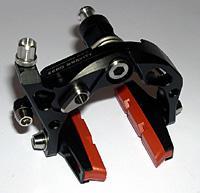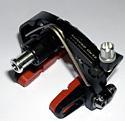
Recently on Cyclingnews.com |
First impressions - October 6, 2004
Things that make you go 'wow'
Zero Gravity brakes
Light weight is all very well, but brakes need to stop you. John Stevenson bolts on a set of Zero Gravity's super light brakes and rolls down the road to find out if their performance is as impressive as their gram count.

|
If you want to make someone who handles a lot of bike parts go 'wow', hand them a Zero Gravity brake. That was the reaction of every rider who visited the office and my kitchen table in the week between our sample of the Zero Gs arriving and me actually fitting them to a bike. (Yes, I leave very expensive bike parts on my kitchen table to impress my friends. I am a sad git - so shoot me.)
According to the Cyclingnews scales, a pair of Zero Gravities weighs 180g. The same scales and Shimano's catalog put a pair of Dura-Ace brakes at 315g (rounding to the nearest 5g, but the way - manufacturing tolerances mean you always see a variance of a gram or two). For a component as small as a brake, that's a pretty staggering difference. The latest Zero G (which is what we have here, except for the new lighter brake pads Kool Stop have developed for the brake) is lighter than the early 2004 version by almost 20g. How does Zero Gravity designer Ted Ciamillo do it?
For starters, the Zero Gravity brake is a very minimalist design. Both arms pivot around the centre bolt, which means weight is saved over the dual-pivot design that's now almost universal in high-end brakes. However, if the Zero Gs were an old-style single pivot they wouldn't work very well with today's brake levers, which are designed for the greater mechanical advantage of dual pivot brakes. Ciamillo solves this problem with a simple but ingenious cam that increases the leverage at the brake without adding a great deal of weight.
Ciamillo clearly believes in doing more with less as the pivot for the cam incorporates a quick release mechanism that dispenses with the usual quick release on the cable anchor bolt housing. Further weight is saved by keeping the brake arms short and using titanium and aluminium instead of steel wherever possible. It has to be said that it's slightly disconcerting to be tightening 4mm titanium hex bolts to anchor cables and brake pads instead of the usual steel 5mm jobs. These are not components for the ham-handed mechanic, but we exercised normal care in assembly, had no problems and everything stayed put in subsequent riding.
To further conserve mass, the Zero Gravity brake's minimalist brake arms are CNC-machined from solid 7075 aluminium. CNC-machining is a manufacturing technique that has pros and cons, even though it tends to be used by marketroids as an unalloyed positive buzzword. The upside is that you can use the very strongest possible materials for CNC machining, materials that may not be suitable for the forging and casting processes used in large-scale mass-production. Another advantage is that CNC-machining is a great way to make relatively small quantities of a component, where it may not be economical to make moulds for forging.
|
|
|
|
|
The downside of CNC is that a forged part may end up performing better than a CNC-machined part, even if the material used in the CNC process is better, because forging aligns the grain of the metal along the finished shape, which can make for better fatigue life. Lots of components these days are initially forged, then machined to their final shape, because when you want precise control over exactly how much metal ends up where, it's hard to beat a CNC mill.
There's no doubt that the Zero G design is damn clever - but how well do they work? Our first ride was a 60km loop on quiet roads that involved enough descending to put the Zero Gravities to the test - and a return run through heavy traffic as everyone, their uncle and their dog's caravan came back from the beach after a public holiday weekend.
In a nutshell, the Zero Gravity brakes offer very good stopping power, though it's not quite as good as the best brakes avalable. The basis for that comparison is the Shimano Dura-Ace brakes our Zero Gravity brakes replaced on a Trek Madone we have on test (review coming very soon, by the way). The Dura-Ace brakes are easily the best road bike stoppers I've ever used, with lots of well-controlled power. The Zero Gravity brakes are not quite as powerful. Modulation is good; it's easy to feed power into the brake, and they're not in the least bit grabby - you'd have to do something very, very silly indeed to put yourself over the bars. There is enough power here that you could, though; there's just not quite the feeling of having loads of spare stopping ability in reserve that you get from the Dura-Ace brakes.
Nevertheless I was perfectly happy descending at the limit of my bike handling ability with the Zero Gravities - there's more than enough stopping power here.
Whether the $355/pr asking price of the Zero Gravity brakes constitutes good value for money or not is a question I'll leave up to you. It's a heck of a lot of money for a set of brakes, but if weight matters to you, it may not be too much to pay.
A full review will follow after some serious tarmac time.
More info: Zero Gravity website
Weight: 180g/pr
Price: $355
Photography
Images by Paul Mirtschin/Cyclingnews.com
- Zero Gravity brake - light but effective stoppers
- Front view - the elliptical lever on the left side is the quick-release cam
- The cam (lower right) gives the Zero Gravity brakes almost double-pivot stopping power with a lot less mass
- In action - the cam increases the mechanical advantage to compensate for the lack of a double-pivot long arm




